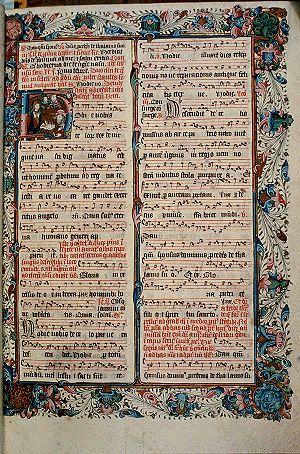
Ranworth Antiphoner
Encyclopedia

Illuminated manuscript
An illuminated manuscript is a manuscript in which the text is supplemented by the addition of decoration, such as decorated initials, borders and miniature illustrations...
antiphoner
Antiphonary
An Antiphonary, Antiphonal, "Antiphony" or Antiphoner is one of the present Catholic liturgical books. It is intended for use in choro An Antiphonary, Antiphonal, "Antiphony" or Antiphoner (Latin antiphonarium, antiphonarius, antiphonarius liber, antiphonale; Greek ’antíphonon, antiphon,...
. It was used at St. Helen's Church, Ranworth
Ranworth
Ranworth is a village in Norfolk, England in The Broads, adjacent to Malthouse Broad and Ranworth Broad.-Church of St Helen:The 14th century St. Helen's church has a fine 15th century painted rood screen and a rare Antiphoner. It is a Grade I listed building From the top of Ranworth church's 100...
prior to the Reformation
Protestant Reformation
The Protestant Reformation was a 16th-century split within Western Christianity initiated by Martin Luther, John Calvin and other early Protestants. The efforts of the self-described "reformers", who objected to the doctrines, rituals and ecclesiastical structure of the Roman Catholic Church, led...
. It disappeared for about 300 years. In the 1850s it was in the collection of Henry Huth
Henry Huth
Henry Huth was an English merchant banker and prominent bibliophile.-Early life:He was the third son of Frederick Huth of Hanover, who settled at Corunna in Spain. Frederick Huth left Spain during the Napoleonic Wars, with his family under convoy of the British squadron, and landed in England in...
. Its provenance was not appreciated until 1912, when it was offered for sale. It was bought and returned to Saint Helen's Church where it is now on display.
The manuscript was bequeathed to the church in 1478. It was produced by the monks of Langley Abbey
Langley Abbey
Langley Abbey was an abbey in Norfolk, England.There are remains of the church and barn as well as earthworks of other buildings and fish ponds. The site was partially restored and opened to the public to a museum in 2010....
and consists of 285 vellum
Vellum
Vellum is mammal skin prepared for writing or printing on, to produce single pages, scrolls, codices or books. It is generally smooth and durable, although there are great variations depending on preparation, the quality of the skin and the type of animal used...
pages of writing and illustrations, with daily services in medieval Latin
Medieval Latin
Medieval Latin was the form of Latin used in the Middle Ages, primarily as a medium of scholarly exchange and as the liturgical language of the medieval Roman Catholic Church, but also as a language of science, literature, law, and administration. Despite the clerical origin of many of its authors,...
and 19 miniatures.

